Pretty, it's not.






 (This woman's breast implants are not only encapsulated, but have travelled east & west)
(This woman's breast implants are not only encapsulated, but have travelled east & west)
(Hand & thumb of a 46-year-old anorexic woman)
Follow on Buzz






 (This woman's breast implants are not only encapsulated, but have travelled east & west)
(This woman's breast implants are not only encapsulated, but have travelled east & west)
(Hand & thumb of a 46-year-old anorexic woman)
Follow on Buzz
Posted by
Medusa
at
8:16 PM
12
comments
![]()
Labels: anorexia, anorexic, arms, body, breast, encapsulated, hand, legs, pro ana, protruding veins, roadmap, starvation, thinspiration, veins, vena, venae


From the Intervention series on A&E is this story of Emily, who has been suffering from anorexia for 8 years, and the desperate attempts of her family and identical twin, Tiffany, to help her. At the time of filming, Emily, who is 5 feet 8 inches tall, weighed only 94 pounds, 56 pounds less than her twin, Tiffany.
Emily

Emily & Tiffany, identical twins...
PART 1:
Emily exercising in the shower
Tension and frustration...
PART 2:


Food counting: "A plate of ritual"...
PART 3:
The intervention: "You're not going to love her to death"...
PART 4:
"The way we started life is the way I want it ended -- with you at my side" (Tiffany to Emily)
PART 5:
UPDATE!
Emily, March 2009
Intervention did a follow-up on Emily in March of 2009. Click the link below to watch the video. It's amazing...
INTERVENTION: UPDATE ON EMILY
Follow on Buzz
Posted by
Medusa
at
11:00 PM
23
comments
![]()
Labels: anorexia, anorexia nervosa, eating disorder, Emily, food counting, food rituals, Intervention, pro ana, starvation, Tiffany, twins
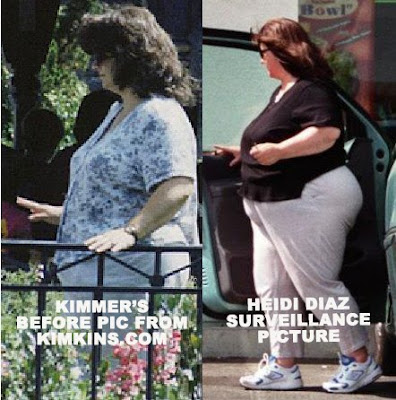
Heidi Diaz (aka Kimmer) who never followed her own diet, but that didn't stop her from telling others to starve themselves
And here are the women who tragically died while following the Lighterlife diet:

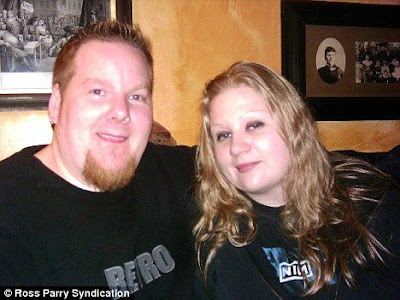
Samantha and her fiancé, Andrew
34-year-old Samantha Clowe collapsed at her home in Leeds, UK from heart failure in June of 2009 after following the LighterLife diet for 11 weeks.
Samantha weighed 17st 6 lb (244 lbs) when she started the diet, and had lost three stone (42 lbs) by following the strict plan, desperate to be slender in time for her wedding to fiancé, Andrew Smith.
Jacqueline Henson:
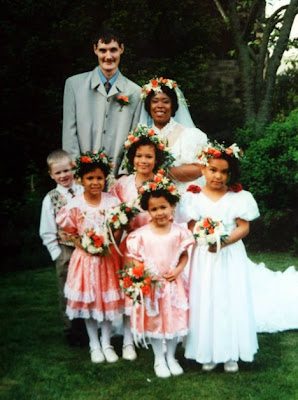 Jacqueline and Brian Henson on their wedding day
Jacqueline and Brian Henson on their wedding day
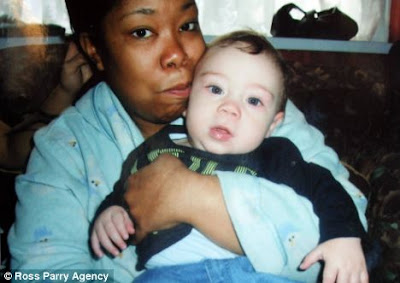
Jacqueline & her grandson
"Jacqueline Henson, 40, was ‘over the moon’ when she shed 11 and a half pounds in the first week on the Lighter-Life diet, which involves drinking four litres of water a day..
‘Jacqui was told by the slimming consultant that the more water she drank the more weight she would lose.
'It wasn’t made clear to her that you had to spread the drinking through the day.’
A post mortem examination revealed Mrs Henson died from swelling of the brain caused by saturating the body with too much water. "
Matilda Callaghan: 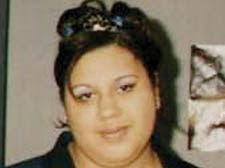
Matilda Callaghan, 25, died in January 2006 after losing 10 stone (140 pounds) in six months on the Lighterlife diet.
A post-mortem found Matilda died from heart arrhythmia – when a heartbeat is not allowed sufficient time to ‘recover’ and the next beat interrupts.
For six months Matilda lived on only 500 calories a day, 1,500 less than the recommended daily amount, and was drinking between four and six litres of water daily.
~~~~~
So, so sad. All these deaths, and Lighterlife continues to thrive and Jackie Cox keeps raking in the money. Scandalous.
To read the full stories on Samantha, Jacqueline and Matilda, click these links below:
Jacqueline Henson
For more information about Kimkins and Heidi Diaz, click here:
Mariasol
Follow on Buzz
Posted by
Medusa
at
7:36 PM
4
comments
![]()
Labels: anorexia, bulimia, death, eating disorders, Heidi Diaz, Jacqueline Henson, Kimkins, Kimmer, Lighterlife, Mariasol, Matilda Callaghan, Samantha Clowe, starvation diet

I truly wonder how many other ignoramuses in the world believe this.
UPDATE: And this further comment just in from Anonymous:
Anonymous said...
Follow on Buzz
Posted by
Medusa
at
5:37 PM
30
comments
![]()
Labels: Aimee Moore, anonymous, anorexia, bulimia, comment, ignoramus
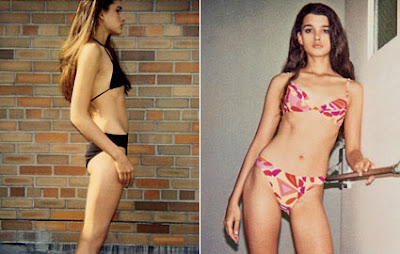
Crystal Renn (2002), age 15, 95 to 105 lbs, at the height of her eating disorder
(Photos from the author's personal collection)
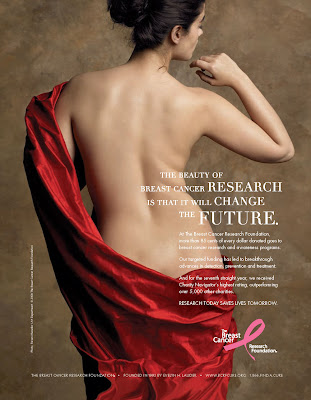 Crystal Renn by Ruven Afanador
Crystal Renn by Ruven AfanadorFollow on Buzz
Posted by
Medusa
at
8:08 PM
5
comments
![]()
Labels: Crystal Renn, eating disorder, Hungry, model, plus-size model, recovery, starvation

From HBO:
Thin
Eating disorders affect five million people in the U.S., and more than 10% of those diagnosed with anorexia nervosa will die from the disease. Seeking to put a human face on these sobering statistics, acclaimed photographer Lauren Greenfield went inside a Florida treatment center to tell the stories of four women who are literally dying to be thin. The devastating HBO documentary THIN reveals what she found there - and explores the issues underlying their illness.
UPDATE: HBO expresses its deepest sympathy to the family of Polly Williams for their tragic loss.
THIN:
UPDATE: The documentary, THIN, has been removed from previous links to other sites I had provided in this post due to claims of copyright infringement.
I do, however, have a personal copy of the documentary. If you would like to view it, please write me at gorgon@2medusa.com.
Click below to read more about Shelly Guillory and Polly Williams:
Follow on Buzz
Posted by
Medusa
at
5:50 PM
3
comments
![]()
Labels: anorexia, anorexic, bulimia, bulimic, eating disorders, Shelly Guillory, THIN documentary Polly Williams
 Polly Ann Williams
Polly Ann WilliamsMore about Polly...
ANOREXIA: AN UPDATE FROM SHELLY FROM THE HBO DOCUMENTARY, THIN...
and
Follow on Buzz
Posted by
Medusa
at
1:02 AM
6
comments
![]()
Labels: binge, HBO, Holly Huber, laxatives, Polly Ann Williams, Polly Williams, purge, Shelly Guillory, starvation, THIN, thinspiration, thinspo, video



"BRYAN BIXLER IS THRIVING! [UPDATE: JULY 12, 2015]"
"ANOREXIA TURNED ME INTO AN OLD LADY..."
RACHEL & CLARE WALLMEYER: THE WALLMEYER TWINS HAVE DIED IN A FIRE...[UPDATED AUGUST 27, 2012]
VOGUE ITALIA ROCKS THE CURVES ON ITS JUNE COVER...
TONI'S STORY: "I AM FIGHTING THIS BATTLE ON MY OWN...I AM TRYING TO LIVE."
LEANN RIMES TWEETS SHE'S "COMPLETELY HEALTHY"...
CRYSTAL RENN: SLIP SLIDING AWAY...
RUTH'S STORY: "I KNOW THE DARK PLACE ONE MUST BE IN TO BE SELF-DESTRUCTIVE."
RILEY'S STORY: "I'M A 15 YEAR OLD BOY...AND HAVE BEEN SUFFERING FROM AN EATING DISORDER."
BULIMIA QUICKLY CLAIMS ANOTHER VICTIM: REST IN PEACE, KYLIE
MARIE CARO, THE MOTHER OF ISABELLE CARO, COMMITS SUICIDE
MRIANA'S STORY: "I TOOK CONTROL OF MY LIFE, REFUSING TO LET ANYONE ELSE DO IT FOR ME."
EMMA'S STORY: "ALL I EVER WANTED WAS LOVE."
SHAYE'S STORY: "MY BULIMIA BATTLE AND RECOVERY."
VAL'S STORY: "I WAS NEVER DIAGNOSED WITH DEPRESSION OR BIPOLAR BUT I KNOW SOMETHING IS WRONG."
BELLE'S STORY: "DO NOT LET 'ANA' OR 'MIA' INTO YOUR LIFE. THEY WILL NEVER EVER LEAVE."
ELIS'S STORY: "CHEW AND SPIT WAS PART OF MY EVERYDAY HABIT."
ISABELLE CARO: REST IN PEACE, DEAR ISABELLE (1982 - 2010)
TERESA'S STORY: "...IT IS POSSIBLE TO RECOVER, BE HEALTHY AND GET SOME RELIEF FROM THE ED VOICE."
SHANNICE'S STORY: "I'M NOT ANOREXIC. I'M NOT BULIMIC. I DON'T KNOW WHAT I AM."
CHLOE'S STORY: "MY TWIN SISTER DEVELOPED BULIMIA WHEN SHE WAS 13 YEARS OLD. I AM ANOREXIC."
NATALIA'S STORY: "I HAVE EVERYTHING AND I STILL FEEL LIKE I HAVE TO BE THIN TO BE LOVED."
NATASHA'S STORY: "BEFORE TAHAYNA PASSED AWAY SHE SAID TO ME, 'NO MATTER WHAT, STAY STRONG...'"
JOY'S STORY: "HOW SECRECY TURNED A DIET INTO THE REST OF MY LIFE IN A MATTER OF DAYS."
NATASHA'S STORY: "I WAS RAISED THINKING I HAD NO WORTH, NO PLACE IN THIS WORLD."
MAY'S STORY: "THE OTHER GIRLS IN RECOVERY WERE ANGELS...I CALL THEM SISTERS OF SORROW."
LIZA'S STORY: "MY LIFE WAS SAVED BY A STRAY CAT..."
DENISA'S STORY: "I ESCAPED. AND CONTINUED IN MY MADNESS."
ANA'S STORY: "I'M LIKE A BROKEN LITTLE BIRD WHO NEEDS SOME LOVE AND CARE..."
JAN'S STORY: "I HOPE YOU'LL ALSO FIND OUT ONE DAY THAT LIFE'S WORTH TO BE LIVED."
STARVATION = SKIN & BONES = DEATH
A PLEA FOR HELP FROM TASHA, A 12-YEAR-OLD GIRL...
OLIVER'S STORY: "BEING A MAN, I FEARED I WOULD NOT BE TAKEN SERIOUSLY..."
MORGAN'S STORY: "MY WHOLE LIFE I'VE NEVER BEEN 'BLACK ENOUGH' OR 'GOOD ENOUGH...'"NAOMI'S STORY: "BELIEVE THAT YOU CAN GET OUT OF THIS!"
KAREN ELIZABETH'S STORY: "THE GUN HAD BEEN LOADED FOR A LONG TIME..."
JEREMY GILLITZER: A SHADOW OF HIS FORMER SELF [Update: REST IN PEACE, JEREMY]
SIMEONS' PROTOCOL & THE DANGEROUS hCG DIETARGY'S STORY: "MY DAY TO DAY WITH THIS MONSTER THAT LIVES INSIDE OF ME FOR OVER 8 YEARS..."
MIKAYLA'S STORY: "I AM CONSTANTLY FIGHTING A BATTLE BUT I WILL NEVER LET ANA WIN."
NATALIA VODIANOVA, WILL YOU STEP UP TO THE PLATE?
DID YOU KNOW THAT THE 3rd LEADING CAUSE OF DEATH FOR THOSE BETWEEN THE AGES OF 15 AND 24 IS SUICIDE?
BULIMIA: A MOTHER SHARES ON FILM THE LIFE AND DEATH OF HER BULIMIC DAUGHTER, MELISSA SARAHLYNN'S STORY: "MY MOM DIED A FEW MONTHS AGO FROM COMPLICATIONS FROM HER ANOREXIA" LARISSA'S STORY: "IT'S SO MUCH EASIER TO FALL INTO AN EATING DISORDER THAN TO GET BACK OUT AGAIN" VICKI'S STORY: "MY MUM DIED LAST WEEK. ED TOOK EVERYTHING FROM HER."
ANOREXIC, BULIMIC, PRO ANA / MIA? SOME TIPS, IF YOU WANT TO LOOK LIKE THIS...[UPDATED WITH A COMMENT FROM BONYPINK]
ROBIN'S STORY: "I'M IN EATING-DISORDER PURGATORY"...
JESSE'S STORY: "I'M A NON-PURGING BULIMIC...EVERY BITE OF FOOD THAT CROSSES MY LIPS IS AN INDICTMENT."
LOULOU'S STORY: CON MAN STEALS MORE THAN FAMILY'S MONEY IN PHONY ED TREATMENT CENTRE SCAM...
NIINA: "DO YOU REMEMBER THE GIRL WE TEASED?"
AMY'S STORY: " I AM A GYM JUNKIE..."
HOW COULD ANY PRO-ANA FIND THESE PICTURES "THINSPIRATIONAL"?
CANADIAN DESIGNER, MARK FAST, BREAKS THE SIZE-O BARRIER...
CRYSTAL RENN ROCKS THE RUNWAY AT JEAN-PAUL GAULTIER SHOW...
NIINA'S STORY: "I'M STILL STUCK IN A VICIOUS CIRCLE..."
MALLORY'S STORY: "MY LIFE DIDN'T BEGIN WITH BULIMIA AND DIDN'T END WHEN I GOT HELP..."
IS KENDRA WILKINSON'S HEAD ON THE WRONG BODY?
JESSICA’S STORY: “A NEW HOPE THAT I WILL BE ABLE TO GLUE THE PIECES BACK TOGETHER…”
CRYSTAL'S STORY: "TEETERING ON THE BRINK..."
SKIN & BONES: THE MODELS ON LOVE MAGAZINE'S FEBRUARY COVERS
BEFORE SIZE ZERO: THE WAY WE WERE...
JANELLE'S STORY: "WHY IS SOMETHING WRONG WITH ME?"
KAREN-ANN COONEY: HER WORDS IN A VIDEO BEFORE HER TRAGIC DEATH...
RENNIE'S STORY: "I HOPE I GET HELP BEFORE I DIE."
EM'S STORY: "THIS IS NO WAY TO LIVE..."
THE EMACIATION OF RACHEL ZOE...
CYBER-BULLYING & THREATS ARE ALIVE AND WELL ON THE ZERO-CARB FORUM [UPDATED JANUARY 25, 2010]...
TESSA'S STORY: "MY TIME WILL COME TO TELL THE TRUTH..."
ANOTHER DEATH FROM ANOREXIA: REST IN PEACE, SUE...
WHEN SHE LOOKS IN THE MIRROR SHE SEES FAT...
KRISTY'S STORY: "ALL IS NOT LOST FOR ME..."
MANDY'S STORY: "AT THE END OF THIS ROAD, I MIGHT CATCH A GLIMPSE OF ME"
VELVET SCARLETT: AN UNFINISHED STORY...
PRO ANA? RESTRICTING? STARVING? THE FUTURE'S NOT PRETTY...
HOLLY'S STORY: BEAUTY...
FROM BULIMIA TO RECOVERY: ALEXIS'S JOURNEY...
JAC'S STORY: "IT WON'T ALLOW ME TO CONSUME, BUT IT CONSUMES ME"...
A CRY FOR HELP: CHARLI'S STORY...
PRO ANA? SOME MORE THINSPO FOR YOU...
TEARS ARE NOT ENOUGH: WHEN CRUELTY GOES BEYOND THE PALE
EATING DISORDERS DO NOT DISCRIMINATE: ALISHA'S STORY...
EATING DISORDERS & RECOVERY: ARIELLE'S "MANTRA"...
ERASING THE YEARS WITH PHOTOSHOP...
AN OPEN INVITATION: SHARE YOUR STORY, THOUGHTS, OPINIONS...
DEMI MOORE: A TALE OF A BALMAIN DRESS, A MISSING HIP, A BODY SNATCHER, AND A PHOTOCHOPPER
ANOREXIC TWINS: SONIA & JULIA'S STORY
THE SKINNY ON RALPH LAUREN & THE PHOTOSHOPPING DEBACLE...
WOULD SOMEONE PLEASE STUFF A SOCK IN KARL LAGERFELD'S PIE HOLE?
PROTRUDING VEINS...THE TWISTED, BLUE ROADMAP: IN VENAE VERITAS
THE LIGHTERLIFE DIET, STARVATION, AND ANOTHER DEATH...
ANYTHING YOU'D LIKE TO SAY TO "ANONYMOUS"?
CRYSTAL RENN: NO LONGER HUNGRY...
IN LOVING MEMORY: POLLY ANN WILLIAMS
KUDOS TO LIZZI MILLER, IN ALL HER UNPHOTOSHOPPED GLORY...
FROM ANOREXIA TO RECOVERY: TWINS, MONICA & GABRIELA IRIMIA (THE CHEEKY GIRLS)
I HAD ALWAYS THOUGHT THIS PICTURE WAS PHOTOSHOPPED...JEREMY GILLITZER: A SHADOW OF HIS FORMER SELF...
ANOREXIA, BULIMIA & THE MINNESOTA STARVATION EXPERIMENT
NOREEN'S AMAZING POST: "HOW ANOREXIA FOUND ME"
LAURA WILSON: FROM AN ANOREXIC BRIDE TO RECOVERY...
MADONNA HAS TAKEN HER FITNESS REGIME A LITTLE TOO FAR...
BULIMIC & USING SYRUP OF IPECAC TO PURGE? IT'S DEADLY...
MALE ANOREXIA: BRYAN BIXLER IS DYING...[UPDATED: January 30, 2011]
MALE ANOREXIA: ADAM JASIULEC BATTLES FOR HIS LIFE...
PRO ANA MIA ? LOOKING FOR THINSPIRATION ?
BULIMIC? SO YOU DON'T THINK PURGING WILL HARM YOU? THINK AGAIN...
ANOREXIA: ISABELLE CARO, STILL STICK THIN [UPDATED: REST IN PEACE, ISABELLE]
THE SHOCKING FACE OF ANOREXIA & BULIMIA...KARLENE IS SUFFERING TERRIBLY[UPDATED]
ANOREXIA: DANA, 8 YEARS OLD AND ANOREXIC
ANOREXIA: IN MEMORY OF ALICE RAE...
RACHEL & CLARE WALLMEYER: THE WALLMEYER TWINS BATTLE ANOREXIA & THE LAW...[UPDATED]
ANOREXIC, BULIMIC, PRO ANA / MIA? SOME TIPS, IF YOU WANT TO LOOK LIKE THIS...
CURVES ARE BEAUTIFUL: CHLOE MARSHALL CROWNED MISS TEEN UK
ANOREXIA: A FEEDING TUBE COULD BE IN YOUR FUTURE...
ANOREXIA: REMEMBERING SAMANTHA & MICHAELA KENDALL (UPDATED: June 8, 2013
LAXATIVES: SWALLOWING EYE DROPS CAN KILL YOU...
KAREN CARPENTER: INTO THE SLIPSTREAM OF ANOREXIA & BULIMIA
KARLENE, MY HEART IS BREAKING...
BULIMIA: FRIEDA CURTIS, REST IN PEACE..
LARA FLYNN BOYLE DESPERATELY NEEDS HELP...
THE SECRET OBSESSION: CHEWING AND SPITTING...THE "CHEW-AND-SPIT DIET"
THE SHOCKING FACE OF ANOREXIA & BULIMIA...KARLENE IS IN HOSPITAL (NOVEMBER 10, 2008)
ANOREXIA & BULIMIA: THAT DOWNY HAIR IS CALLED "LANUGO"
ANOREXIA: LAUREN BAILEY BATTLES BACK FROM THE BRINK TO RECOVERY
PHOTOSHOPPING GONE MAD: THE SKINNY ON THE FAKE & REAL IMAGES OF MODELS ON THE INTERNET...
NOT SURE IF YOU HAVE AN EATING DISORDER? TAKE THIS QUIZ...
ANOREXIA AND BULIMIA: THE TRAGIC LIFE OF AIMEE MOORE [LATEST UPDATE: NOT GOOD NEWS...April 28, 2011)
TERRI SCHIAVO: BULIMIA & ITS DEADLY CONSEQUENCES...
PRO ANA / MIA: "NOTHING TASTES AS GOOD AS THIN FEELS"
BULIMIA KILLS.....WARNING! GRAPHIC PICTURES
SUPER SKINNY ME: THE SHOCKING BBC DOCUMENTARY
TO THE GIRL WHO SAID SHE "WANTS" TO BE ANOREXIC...(UPDATED)
OLANZAPINE: DRUG HELPS ANOREXICS GAIN WEIGHT...>
GERMAN FASHION INDUSTRY STEPS UP TO THE PLATE
AIMEE MOORE: DOES ALL THE MEDIA ATTENTION GLORIFY ANOREXIA & BULIMIA?
A BUM RAP: OUTRAGEOUS ATTACKS ON KAROLINA KURKOVA FOR BEING "TOO FAT"
THE LAST CUT IS THE DEEPEST: BLEEDING TO EASE THE PAIN...
BONES OF CONTENTION ON THE CATWALK...
ANA CAROLINA RESTON: SHE WAS YOUNG, BEAUTIFUL & STARVED TO DEATH
HELLO DARKNESS, MY OLD FRIEND...
ANOREXICS & BULIMICS: WONDERING WHAT THAT DOWNY HAIR IS ON YOUR NECK AND BODY?
THE DEADLY CONSEQUENCES OF BINGEING & PURGING...
PRO ANA & PRO MIA: THE RED & BLUE BRACELETS...
ANOREXIA & BULIMIA: THE HORROR OF GASTROPARESIS
WOMEN OVER 40 STARVING, BINGEING & PURGING...
ANOREXIA NERVOSA: ALARMING SUICIDE STATISTICS
BRIDEOREXIA: A CAUTIONARY TALE FOR BRIDES-TO-BE.....
NEWS FLASH !!! HUNGER HORMONE TRIGGERS OVEREATING...
DEATH ON THE INTERNET: AN ANOREXIC GIRL'S LAST WORDS...
SHOCKING DIARY OF A YOUNG PRO ANA/MIA GIRL...
A FAT BELLY MAY FUEL DESIRE TO EAT MORE...
ANOREXIA: LAURA CROSS FIGHTING FOR HER LIFE...
WARNING !!! A BULGING BELLY = INCREASED RISK FOR DEMENTIA
ARE WE EMOTIONALLY WHAT WE EAT?
LATE ONSET ANOREXIA...A WOMAN IN HER 40s TALKS ABOUT HER STRUGGLES
BEATING YOURSELF UP ABOUT YOUR WEIGHT??? WELL, REAL WOMEN HAVE CURVES...
WARNING TO ANOREXICS: LANUGO IS NOT PRETTY
ISABELLE CARO and ANOREXIA: HER TRAGIC CHILDHOOD & HER CURRENT STRUGGLE TO SURVIVE...
REMEMBERING WHAT ONCE WAS THE BODY IDEAL...
ANOTHER EATING DISORDER EMERGES: DRUNKOREXIA
ANOREXIA: AN UPDATE FROM SHELLY FROM THE HBO DOCUMENTARY, THIN...
THE KIMKINS STARVATION DIET: ANOREXIA AND BULIMIA NOT ONLY AFFECT WOMEN...
TO ANONYMOUS: THERE IS HOPE FOR YOUR GRANDDAUGHTER...
POLLY WILLIAMS, REST IN PEACE ~ CORRECTION
A DOCTOR STRUGGLES WITH ANOREXIA & OSTEOPOROSIS......
MALE ANOREXIA & BULIMIA: AN UPDATE FROM JOHNNY ON ANOREXIA...
ARE YOU ANOREXIC / BULIMIC / PRO ANA / PRO MIA ?
THE DEADLY KIMKINS DIET & EATING DISORDERS...
THROUGH THE EYES OF AN ANOREXIC...
MALE ANOREXIA & BULIMIA: ANOREXIA AND BULIMIA NOT ONLY AFFECT WOMEN...
KIMKINS & ANOREXIA: WARNING !!! ...
WARNING!!! IF YOU'RE DIABETIC & DOING KIMKINS...
KIMKINS MEMBERS: HERE'S WHY YOU'RE LOSING YOUR HAIR...
PRO-ANA / PRO-MIA: LA DANSE MACABRE
ANOREXIA NERVOSA & BULIMIA NERVOSA...AND THEIR LINK TO THE DEADLY KIMKINS DIET
